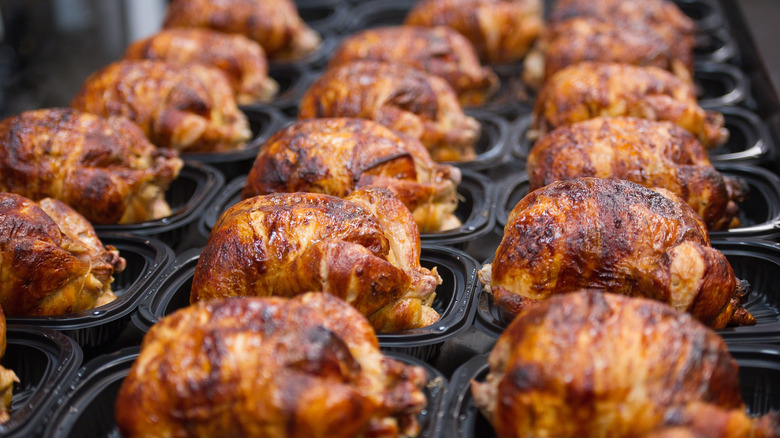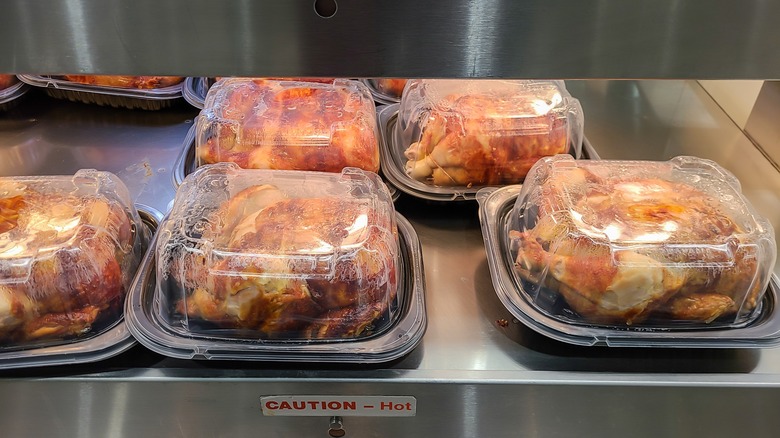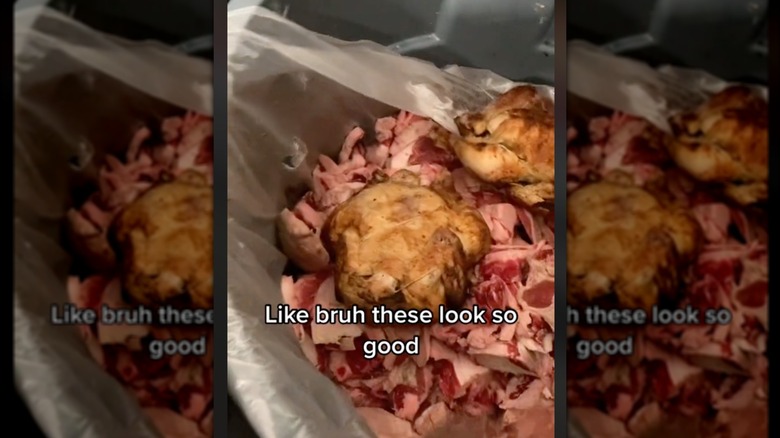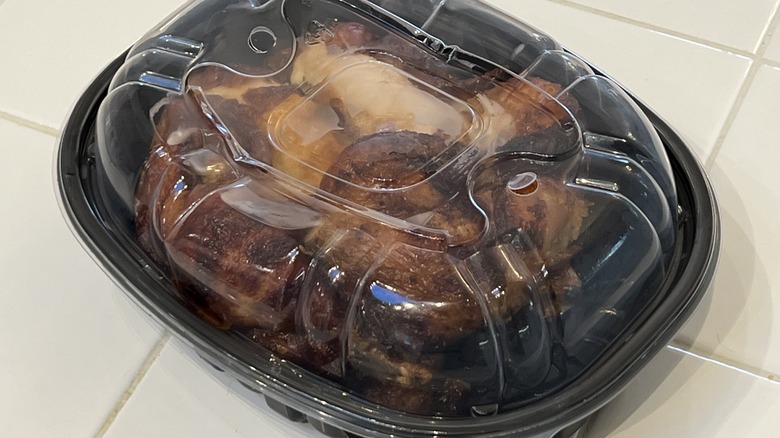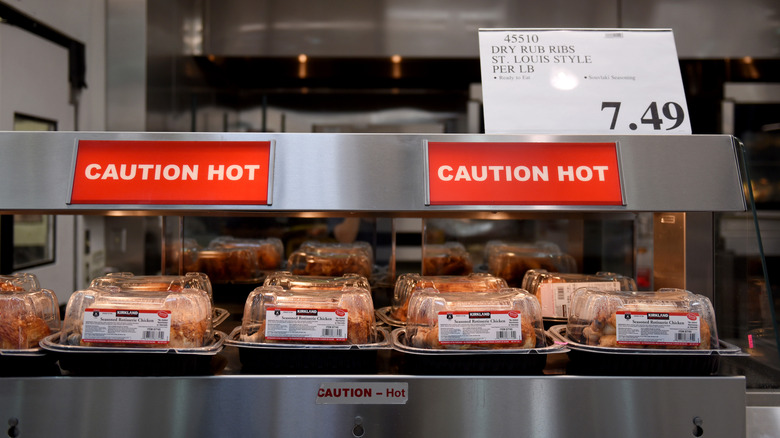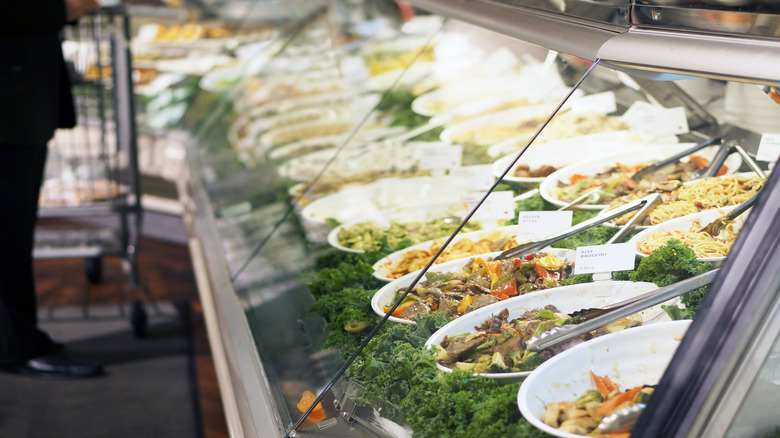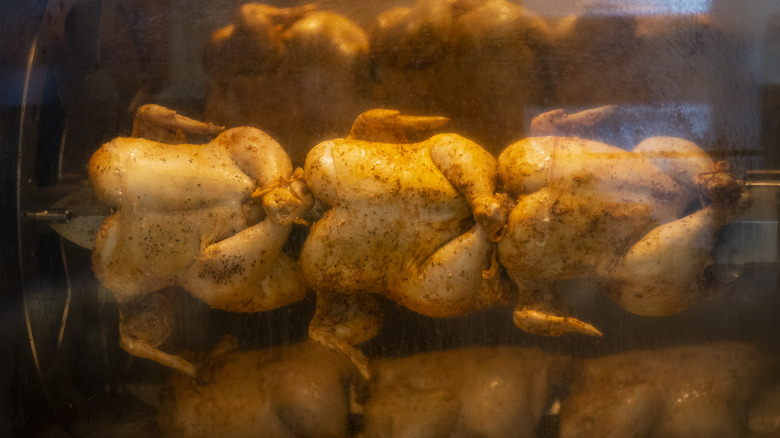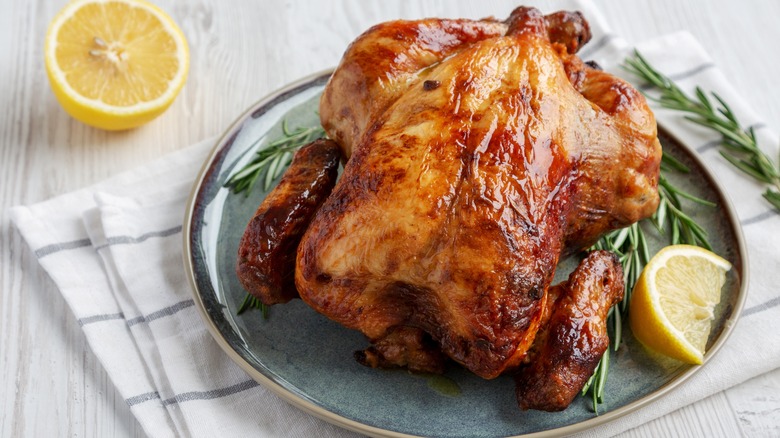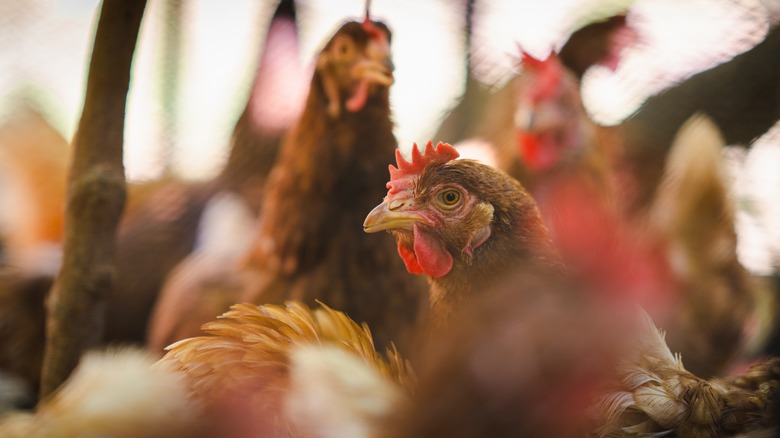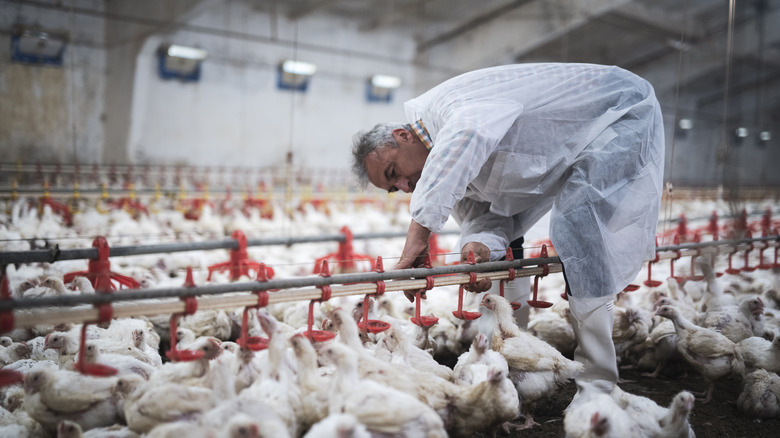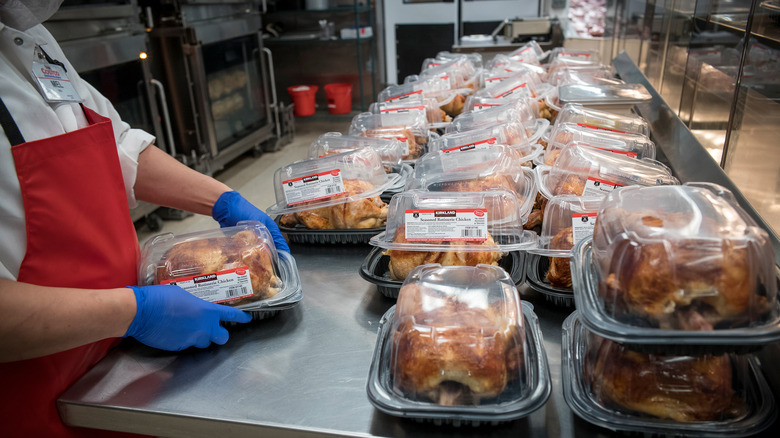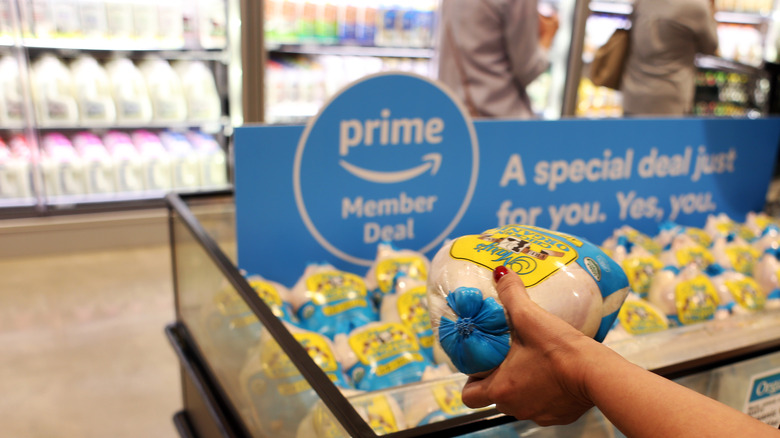What Rotisserie Chicken Vendors Don't Want You To Know
We may receive a commission on purchases made from links.
You stop off at the grocery store after a long day of work, just to pick up a few things, and then you spot it: the perfect, easy, super-convenient answer to the dreaded question, "What's for dinner?" Rotisserie chickens are a godsend for busy home cooks who just want to get something on the table every once in a while, but who don't want to sacrifice a great-tasting meal. Pair a rotisserie chicken with a nice salad, maybe some bread from the bakery, and you've got a dinner you can feel good about. Even if you don't use the rotisserie chicken as the star of your weekday dinner, you might find yourself often picking up one of these birds as a shortcut to your favorite home-cooked meals, whether you're cooking up a batch of homemade chicken noodle soup or cheesy shredded chicken quesadillas.
However, is the helpful and beloved rotisserie chicken as innocent as you think it is? Are there a few secrets lurking behind this bird's crispy skin? Turns out, there's more than just a few secrets. Here are the things rotisserie chicken vendors don't want you to know.
Cheap rotisserie chicken makes you spend more money
Rotisserie chicken often seems like an awesome deal. You get a whole, roasted, delicious bird, cooked and ready to go on the table as soon as you get home, for just a few dollars, maybe $7 at most. What's more, as an NPR report found, even while poultry prices in general increased by a significant amount (more than 15%) last year, the prices for rotisserie chickens stayed more or less the same.
However, these cheap prices come with a cost. Turns out, stores use cheap rotisserie chickens as a ploy to make you spend more money. Rotisserie chickens are well known as a "loss leader" for many stores. The company takes a loss on the product because it knows the product will get you in the store, where you'll very likely spend more money. For example, as the Seattle Times reported, a Costco executive in 2015 noted that they'd be willing to lose $30–$40 million per year just in order to keep rotisserie chicken prices low — the chickens generated enough extra profits to cover it. Think about it. You often walk past lots of other food to get to your rotisserie chicken, foods that would probably go really well with your rotisserie chicken dinner. What's to keep you from throwing a few more items in your cart? Soon, you might find that your anticipated $5 grocery stop is a profitable (at least for the store) $20–$50 dinner.
Stores sometimes waste a lot of chicken
When you walk into a store that sells rotisserie chicken, you can likely expect to find piping-hot chickens available any time of day. However, what happens to the few leftover chickens in the warming case after the store closes up shop? In some instances, those perfectly fine chickens that were properly stored and refrigerated are tossed in the trash.
In 2022, a store employee at an undisclosed location posted a video on TikTok showing a row of several unsold chickens that they were forced to throw away at the end of their shift. In the comments, the poster noted that they'd tried to save the wasted chickens by refrigerating them overnight and putting them back out in the morning, but the chickens were thrown away in the morning by other employees. They also mentioned that trying to take the leftover chickens home would result in termination.
The packaging creates a lot of plastic waste
It's not just chicken that gets wasted when stores fail to sell all the rotisserie chicken stock. Sometimes, both the sold and unsold chickens generate plenty of waste simply via the way they're packaged. The average rotisserie chicken comes in a standard uniform of a black plastic bottom tray and a clear, plastic covering. While you might think, "So what? Just toss them in the recycling bin," dealing with plastic waste resulting from rotisserie chickens is not that easy. In some cases, some recycling centers advise not even trying to recycle the packaging, as the mixed plastic composition is difficult to sort and sell.
Luckily, some stores are making an effort to reduce rotisserie chicken plastic waste. In 2019, Whole Foods, for example, announced it would use bags to package its chickens rather than plastic containers, which it estimated would reduce plastic waste by 70% and 800,000 pounds. Wegmans likewise uses "pouches" that contain 75% less plastic than traditional rotisserie chicken packaging.
Chicken quality and taste can vary based on supplier
If you're a fan of all things Costco, you likely remember the big hoopla that arose in 2022 and again in early 2023, when Costco shoppers began reporting a big problem with their rotisserie chickens. Many complained that recently purchased rotisserie chickens came with a side of chemical flavor. Some Reddit users compared the flavor to chlorine, while other users noted a soapy taste.
However, if you think that this incident can just be chalked up to Costco's rotisserie chicken quality and taste, think again. As one Reddit commenter explained, sometimes, rotisserie chicken quality and flavor can be traced all the way back to the supplier, meaning you could find that, on some days, you could prefer the rotisserie chicken at Costco, other days the rotisserie chicken at Walmart, other days the rotisserie chicken at Sam's Club — and it would all depend on the supplier that the chicken came from, on that particular day.
Some rotisserie chickens are nearly expired or reused to make other products
Could your favorite store's rotisserie chicken have a previous life as another product before you picked it up out of the warming case? Or, if you bypass a rotisserie chicken one day, could that unsold chicken go on to be recycled into another product? According to one PBS report and some Reddit users, that might be just the reality.
Apparently, some stores source rotisserie chickens not from a particular vendor, but from just across the store, in the store's raw poultry aisle. If the store has some whole chickens that are in danger of passing the sell-by date, the employees will take that chicken and turn it into a rotisserie chicken (a product that you likely just assume is fresh and not in danger of expiring). The rotisserie chicken doesn't sell? Well, then the chicken may get an additional new life elsewhere in the grocery store, like in the deli department, where leftover rotisserie chickens are used in products such as chicken salad.
Some contain risky additives
A rotisserie chicken is basically just a roast chicken, right? So, the ingredients list should be pretty short, shouldn't it? Well, not really. Turns out, the ingredients list for a rotisserie chicken can be quite long. For example, a Sam's Club Member's Mark seasoned rotisserie chicken contains about 20 ingredients, including one that it shares with Costco's rotisserie chicken and that you should be wary of — sodium phosphate. Sodium phosphate is a food additive commonly found in deli meats and fast food, among other items, where it helps to cure meat, leaven, emulsify, thicken, and perform other functions. However, it also has some slightly unsavory uses (like in colonoscopies), and you shouldn't consume large amounts of sodium phosphate if you have certain diseases or illnesses, such as kidney disease or colitis (via Healthline).
Furthermore, rotisserie chickens are injected with a sodium solution that contains far more sodium than you might think, such as 550 milligrams of sodium in Sam's Club's chicken. This can all be difficult to keep track of — and seem far sketchier — when you consider that the Food and Drug Administration doesn't require grocery stores to offer nutrition facts and ingredient lists on rotisserie chicken packaging.
Rotisserie chicken contains a lot of sodium and saturated fat
Beyond the added ingredients like injected sodium solutions and sodium phosphate, rotisserie chicken may, in general, not be as healthy as it seems. After all, it's easy to think that a rotisserie chicken is a healthy addition to any meal. It's not fried. It's not red meat. Where are the downsides? Unfortunately, your rotisserie chicken's sodium and saturated fat content can really add up.
The average rotisserie chicken thigh, in a 1-cup serving, contains 452 milligrams of sodium and 5 grams of saturated fat. That single serving of chicken accounts for about 20% of your recommended daily sodium intake and nearly half your recommended daily saturated fat, if you follow a 2,000-calorie-per-day diet. If you remove the chicken's skin before chowing down, you'll save yourself one gram of fat and no sodium, so that sacrifice unfortunately really isn't worth it. The best thing to do? Don't be tricked by rotisserie chicken's seemingly totally healthful persona, and eat this deli treat in moderation.
Costco's rotisserie chickens aren't treated humanely
If you care about eating humanely processed meats and animal byproducts, you may want to steer clear of certain rotisserie chickens. In 2022, shareholders filed a lawsuit against Costco, stating that the brand's chicken processing plant engaged in neglectful and cruel practices, including breeding chickens extra-large for consumption, harming the chickens in the process, and causing them to die prematurely from a range of complications. Furthermore, the lawsuit noted that Costco's practices violated states' animal welfare laws, which could put the company in hot water.
This most recent lawsuit wasn't even the first time that Costco came under fire for its animal mistreatment. The year before, the New York Times detailed some undercover video that was taken in one of Costco's contracted farming facilities and which showed animal mistreatment that resulted in injured and deformed animals. The organization that produced the undercover video demanded that Costco sign the Better Chicken Commitment, guaranteeing better care standards. As of yet, Costco has not signed the commitment.
Workers who process rotisserie chickens might not be treated humanely, either
It's not just the animals that may suffer at the hands of producers in order to guarantee a seemingly never-ending supply of fresh rotisserie chickens at a cheap price. Both workers at processing plants and farmers who oversee the chickens before processing can suffer, too.
As one in-depth report from Taste noted, the farmers contracted to raise these chickens must often take on crippling amounts of debt to do so, and have little rights within the supply chain, often putting them at an economic disadvantage. Employees at processing plants often face dangerous working conditions, many caused directly by employer negligence and abuse. As just one example, Oxfam America has produced a report on the denial of bathroom breaks in the poultry industry, endangering employee health and subjecting them to humiliation. While not directly related to rotisserie chickens, more recently, reports have come out regarding the use of illegal child labor in poultry processing plants, resulting in serious injury and, in some cases, death.
Some rotisserie chickens can make you sick
While you might just assume that just because a rotisserie chicken is kept in the store's warming case it's kept at the right temperature to prevent bacteria growth, that's not always the case, according to a food safety consultant who spoke with Fox 11. They noted that, before you pick your rotisserie chicken from the case, you should give it a quick feel and make sure that it's truly warm to the touch. You should also make sure that the chicken is fully sitting in the heating case. After speaking with the food safety consultant, Fox 11 reported that it visited a grocery store to get a look at its rotisserie chickens, and found that, while management said they monitored the warming case's temperatures every hour, the thermometers in the warming cases didn't even work.
According to the U.S. Department of Agriculture, cooked meat and poultry must be kept at a temperature either below 40 degrees Fahrenheit or above 140 degrees Fahrenheit, in order to stay out of the "danger zone," in which bacteria can begin to rapidly grow in just 20 minutes.
Rotisserie chickens are bred smaller than other store-bought chickens
Are you feeding a crowd and want to get the most meat from a single bird? You might want to bypass the rotisserie chicken and opt for roasting a raw bird yourself. As a representative from the National Chicken Council told Taste, the chickens that you find in the warming case are typically chickens bred specifically to be rotisserie chickens — and that means they're usually smaller, on average, than your standard, raw, whole chicken found elsewhere in the grocery store.
Similarly, an anonymous source told Hi's Eye that, where they work at a Stop & Shop, the store's rotisserie chickens are about half the size or smaller than the store's raw chickens in the poultry case. The publication likewise found that, at a variety of grocery and membership club stores, rotisserie chickens weighed in at around 30–48 ounces, compared to the 80–86 ounces that the raw chickens in the same stores boasted.
